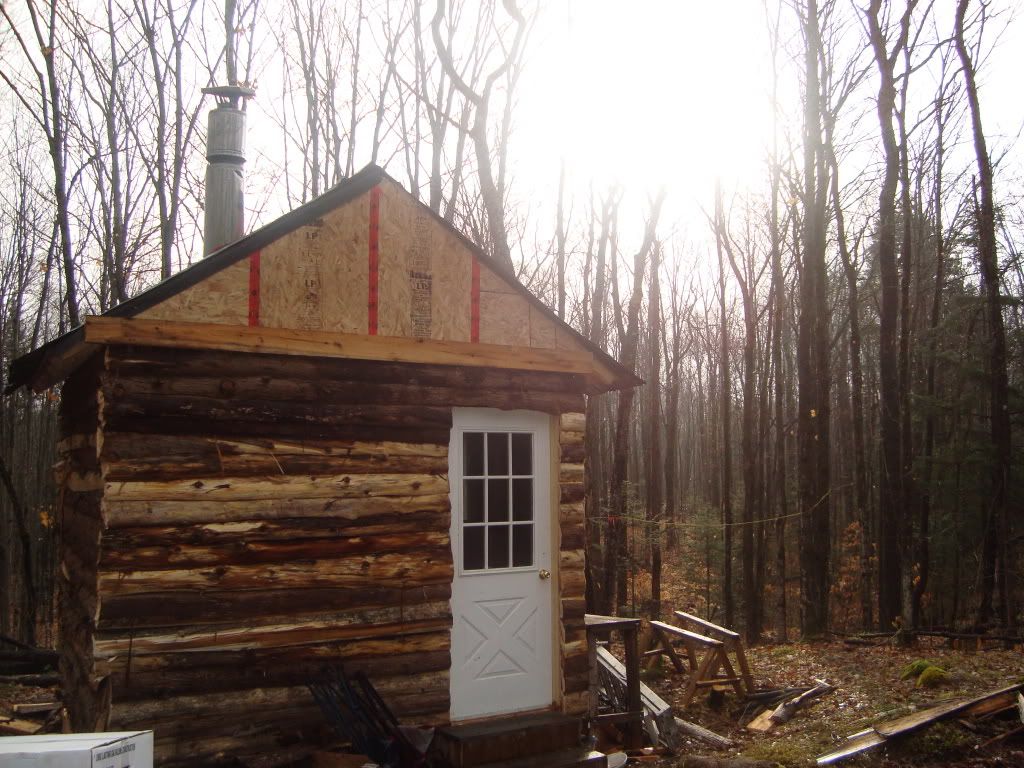Photo of the cabin:
Shed in Ontario
Countryplans.org has some really interesting builds for inspiration when building a small hunting and trapping cabin. I really want to use the birch slab for exterior siding, but still haven't found a way to keep the bark on the birch slabwood.
I searched :keeping birch bark on log: and found the following answer at finehomebuilding.com: Building with natural birch:
"A: Daniel Mack, a woodworker and author in Warwick, New York, replies: White birch is a beautiful but troublesome tree to work with. Also known as paper birch, this tree has bark that can separate in huge, thick sheets from the tree or peel apart into several tissue-thin layers that range in color from iridescent white to beige, yellow, brown or even purple. One of the biggest challenges is never being quite sure exactly how the bark is going to behave.
There are several things to remember when working with this kind of birch. First, cutting the trees in late fall or winter gives the best chance that the paper birch’s bark will stay on. At this time of year, the sap is way down in the roots, and there is less liquid to swell the tree and less sugary sap to feed the many kinds of fungi and microorganisms that thrive in birch.
Birch bark is renowned for its moisture resistance. There is a tremendous amount of oil in the bark, which gives it its waterproof quality. Native Americans used birch bark to cover their canoes and to clad the outsides of their dwellings. However, this waterproof quality also makes birch tricky to work with. The bark seals moisture in the tree, causing it to spall and rot quickly. The process is akin to placing a wet piece of wood in a plastic bag.
The smaller the tree, the better the chances of stabilizing it because there is less wood to retain water. These saplings should be cut in lengths as short as possible to allow for drying. If need be, you can make your moldings from several short pieces mitered together at the branch scars.
For trees over 3 in. in dia., there is no way to treat the bark to eliminate blistering or delaminating from the tree. On a recent job we cut thirty 10-in. dia. birch trees on the same property on the same day, and all of the trees were handled the same. Months later, about half showed signs of peeling bark, and the others still had tight bark.
One way I have avoided the surprises of birch bark is to use it like a veneer over more stable lumber. The bark can be removed from the log, sized, pressed and dried. When ready, it can be applied like veneer with either contact cement or wood glue.
Drying the wood will make it less attractive to certain insects. The best place to dry birch is a well-ventilated low-moisture area, which should give you the best chance of no spall, no rot, no mushrooms and no bugs, but still no guarantees.
Powder-post beetles, for instance, thrive on relatively dry wood. Home treatments for prevention of these beetles include deepfreezing the wood for a week or wrapping it in a plastic bag filled with insecticide. However, neither solution is certain.
My best suggestion is to use gray birch, a relative of paper birch, which is easier to dry and stabilize. You still have to get as much of the moisture out as quickly as possible. I’m not sure that it grows as far north as the Adirondacks, but you might find it nearer your home in New Jersey.
Finally, rustic woodworking by its nature is somewhat mysterious and beyond the total influence of the worker. Adventures and discoveries await you inside the white birch. Whatever happens to the wood, mushrooms growing or bark falling off, contributes to the character and the history of the wood. Rustic woodworking gives you a way to encounter nature and to invent ways of working, improvising and exercising your imagination.
Read more: http://www.finehomebuilding.com/how-to/qa/building-natural-birch.aspx#ixzz3Aha6Srau
Follow us: @fhbweb on Twitter | FineHomebuildingMagazine on Facebook"
I found this article to be very helpful, and I am going to try and dry some of the birch slab, by bunking it, and getting it to a lower moisture content with the bark still on, and hopefully that, along with some small nails, will hold the bark on for a while.
More pics. of random slabwood cabins after the jump:
Spruce slab wood cabin in Alaska:
More pics. of random slabwood cabins after the jump:
Spruce slab wood cabin in Alaska:



Love this, thanks for sharing. Looking for some inspiration on some slab builds here in Alaska.
ReplyDelete